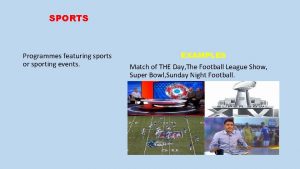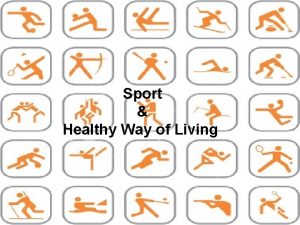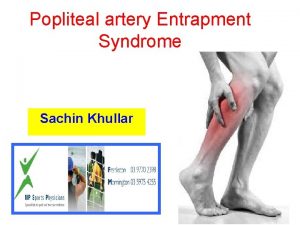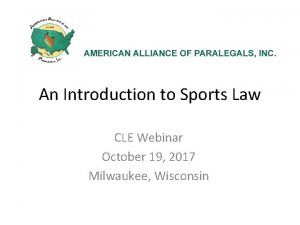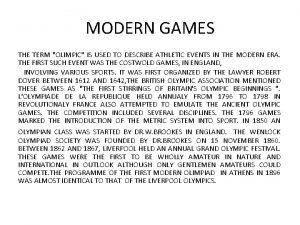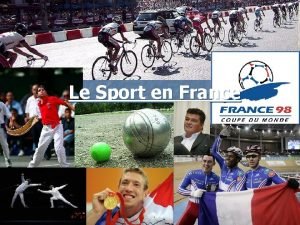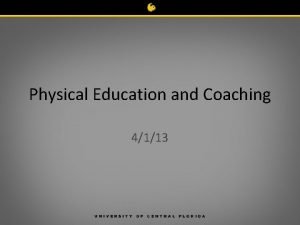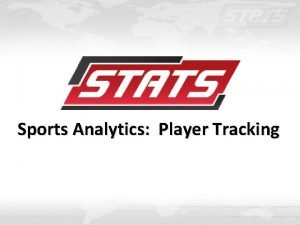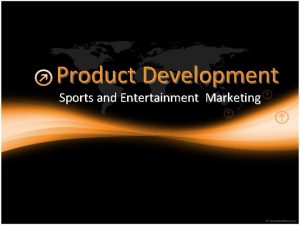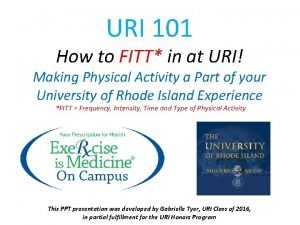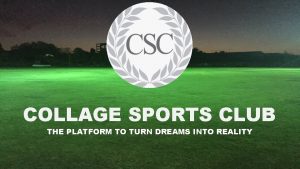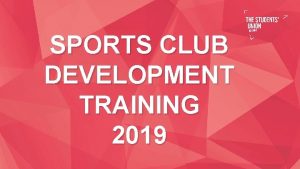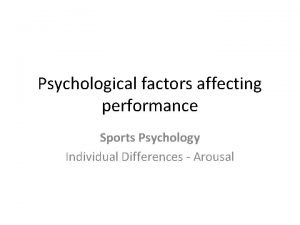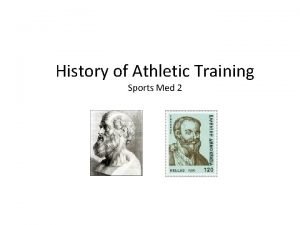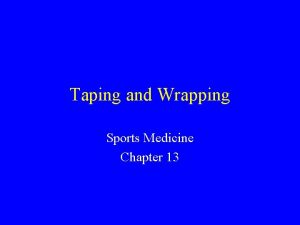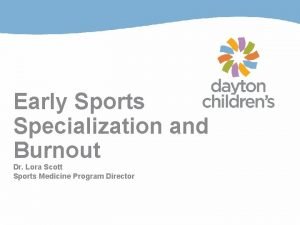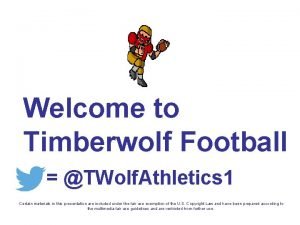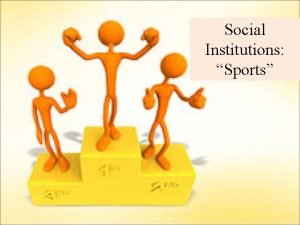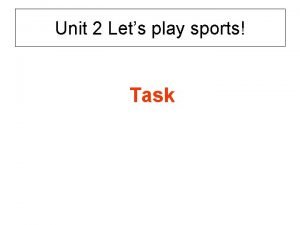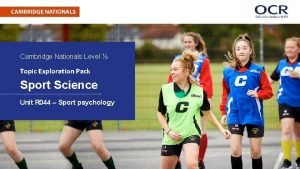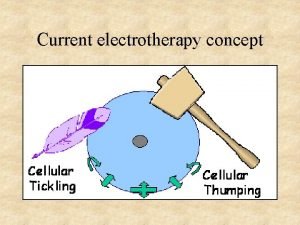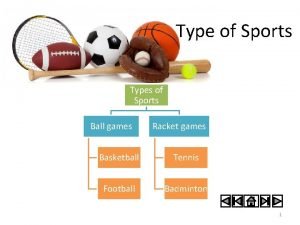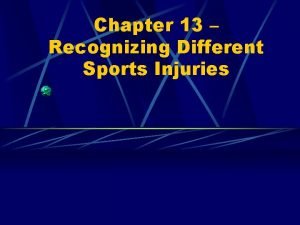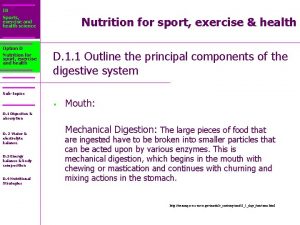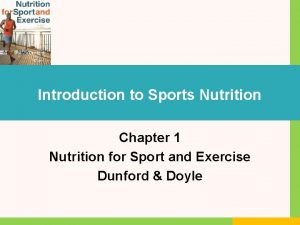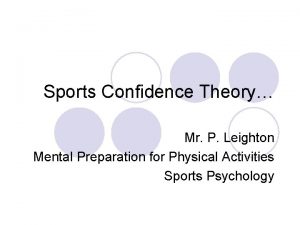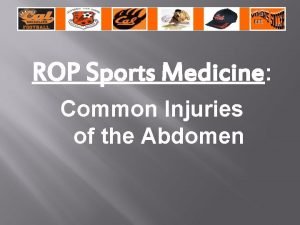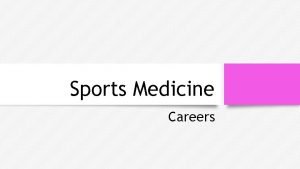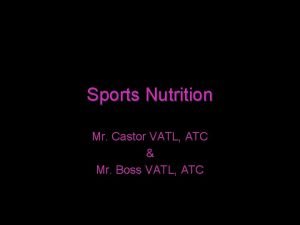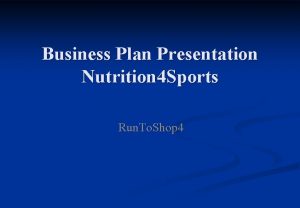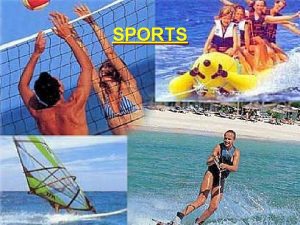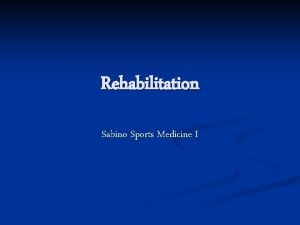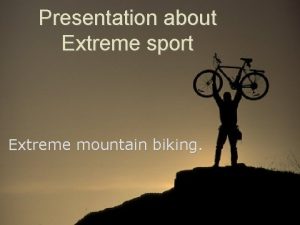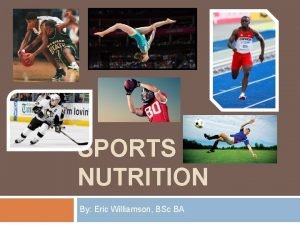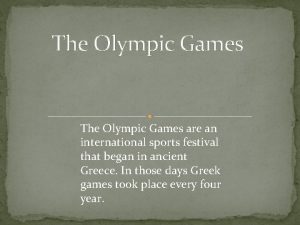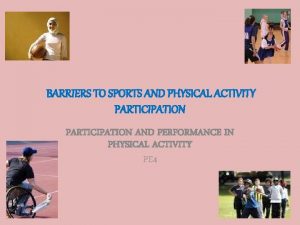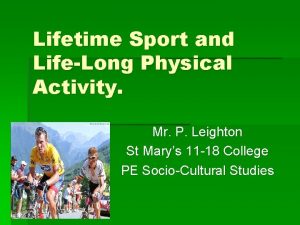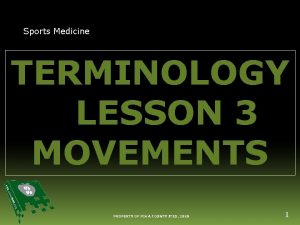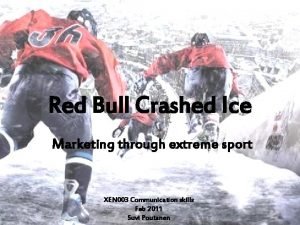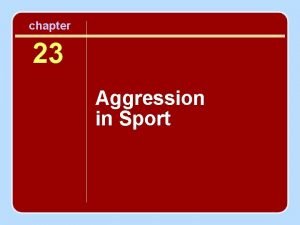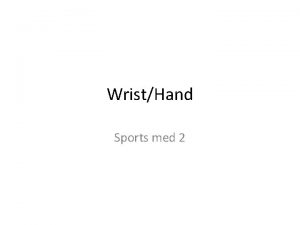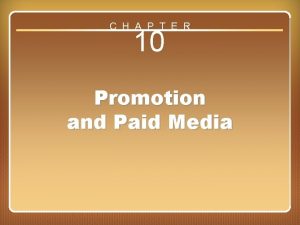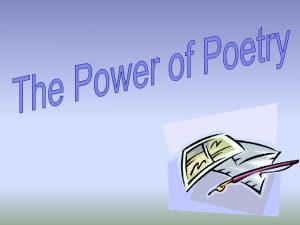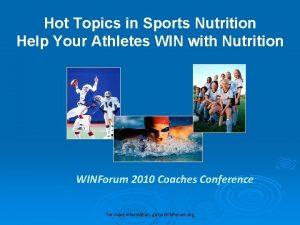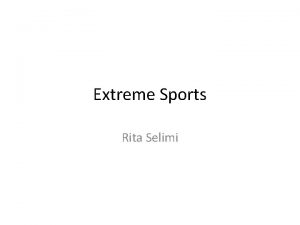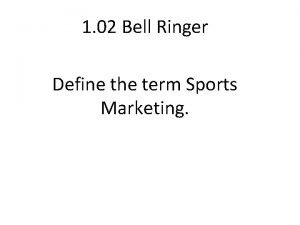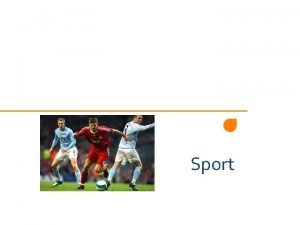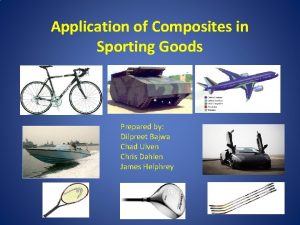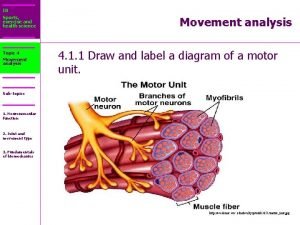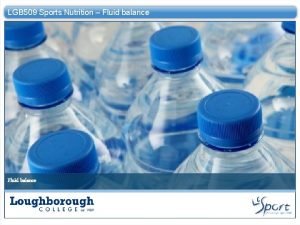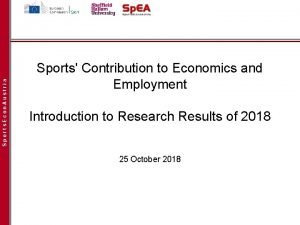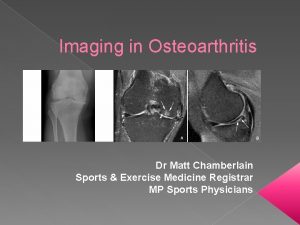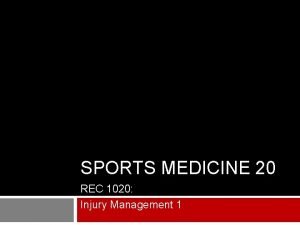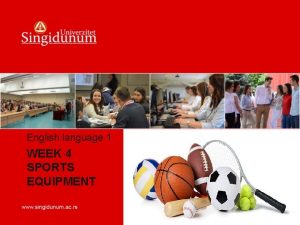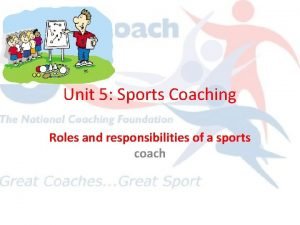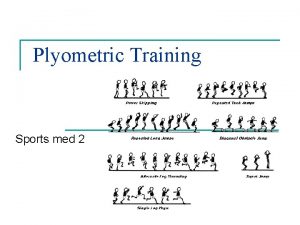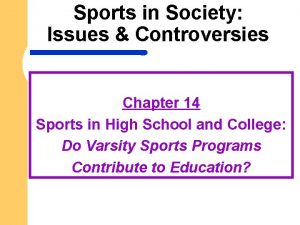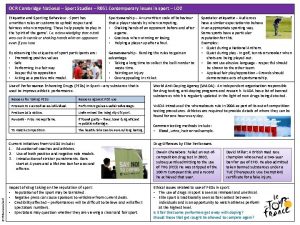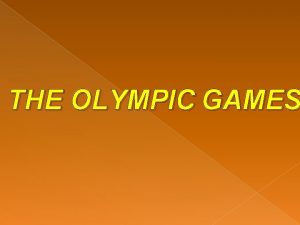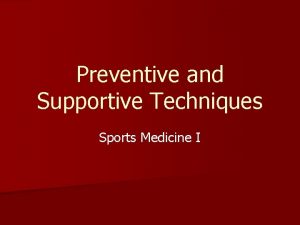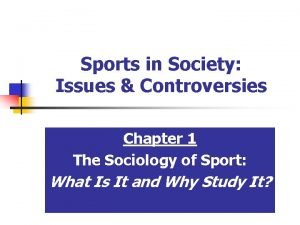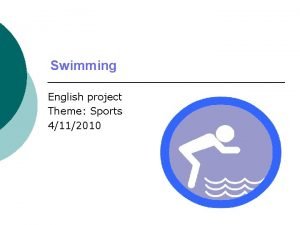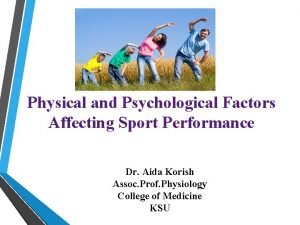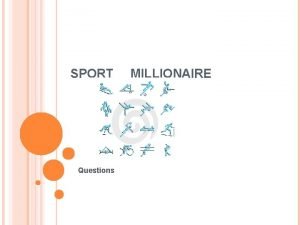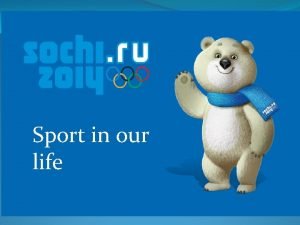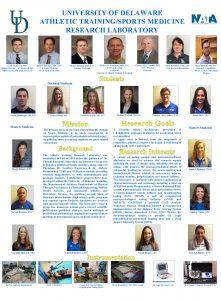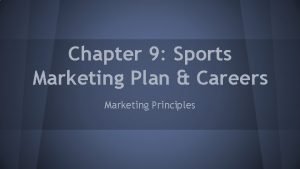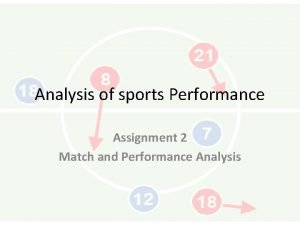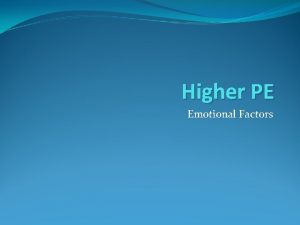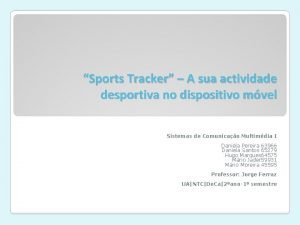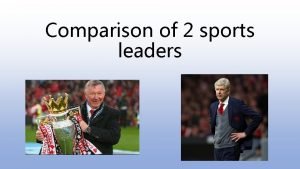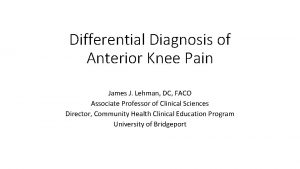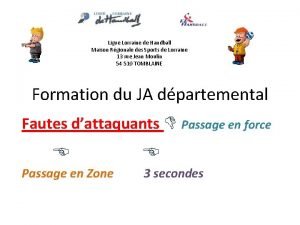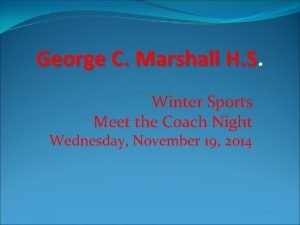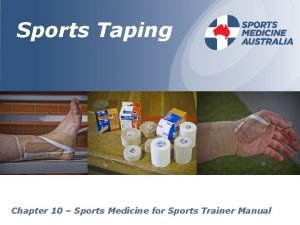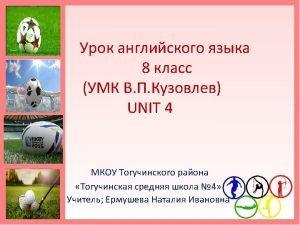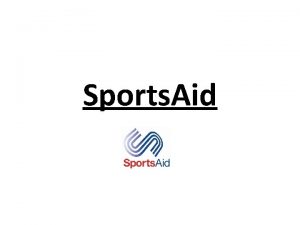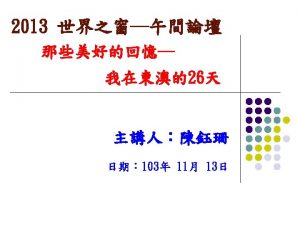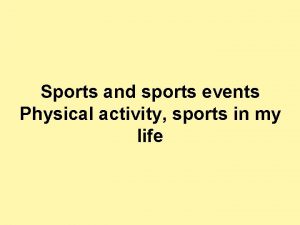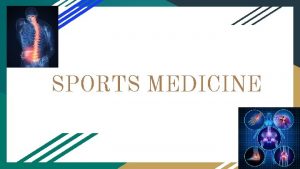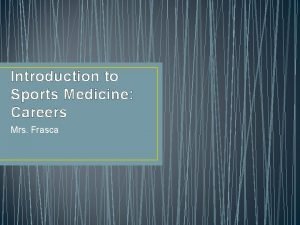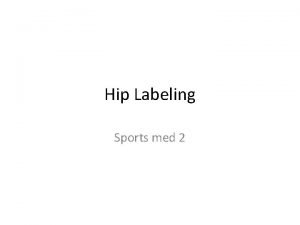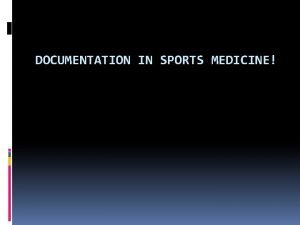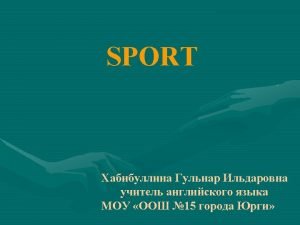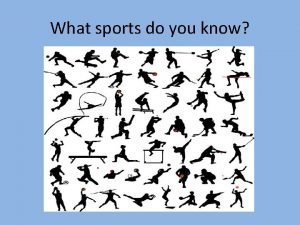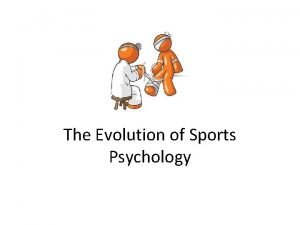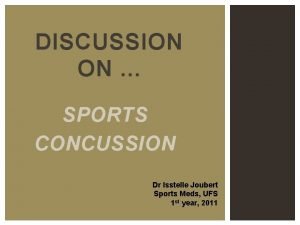CC HAPTER s 13 15 16 HAPTER SPORTS



















































































































































- Slides: 147

CC HAPTER s 13 15, 16 HAPTER SPORTS NUTRITION ERGOGENIC and AIDS AND PERFORMANCE ERGOGENIC AIDS AND PERFORMANCE

Learning Objectives w Review various substances that have been proposed to be ergogenic aids—substances or phenomena that enhance performance. w Learn the importance of including control groups and placebos when studying the ergogenic properties of a substance. (continued)

Learning Objectives w Find out the proposed ergogenic benefits, proven effects, and risks of several pharmacological, hormonal, physiological, and nutritional agents. w Discover which substances that have been considered ergogenic are actually ergolytic—they impair performance.

What About These “Ergogenic Aids” ? !? ! • “Ergogenic” means any substance or procedure that improves: – Physical work capacity – Physiological function – Athletic performance

How These Aids Work? As a central or peripheral stimulant of the nervous system e. g. , caffeine, choline, amphetamines, alcohol, Increase the storage and/or availability of a limiting substrate e. g. , carbohydrate, creatine, carnitine, chromium Act as a supplemental fuel source e. g, glucose, medium-chain triglycerides

How they Work cont. . Reduce or neutralize performance-inhibiting metabolic by products e. g. , pre-exercsie use of sodium bicarbonate, citrate, pangamic acid, phosphate Facilitate recovery e. g. , high-glycemic carbohydrates, water Alter the internal environment to optimize muscle dynamics e. g. , warm-up, hyperoxic breathing

Did You Know…? The placebo effect refers to when your body’s expectations of a substance determine your body’s response to it. While the effect is psychological in origin, the body’s physical response to the substance is real.

THE PLACEBO EFFECT ON STRENGTH GAINS

Pharmacological Agents w Alcohol w Beta blockers w Caffeine w Diuretics w Nicotine

Alcohol w Provides energy (7 kcal/g) but inhibits metabolism w Dulls pain sensation (increasing injury risk); reduces anxiety w Suppresses release of ADH which leads to dehydration w Appears to impair psychomotor function w Has no ergogenic effects on strength, power, speed, or endurance

ALCOHOL SUPPRESSES ADH RELEASE

Nicotine w Increases alertness and may calm nervousness. w Lowers VO 2 max values (when smoked) and peripheral circulation w Increases heart rate, blood pressure, autonomic reactivity, vasoconstriction, ADH and catecholamine secretion, blood lipid levels, plasma glucose, glucagon, insulin, and cortisol w Is addictive and causes various cancers and cardiovascular diseases

Beta Blockers w Prevent the binding of norepinephrine and decrease sympathetic nervous system activity w May improve accuracy (for shooting sports) w Decrease aerobic capacity but have no effect on strength, power, or muscular endurance w Prolonged use can cause bradycardia, heart blockage, hypotension, brochospasm, fatigue, and decreased motivation

Caffeine w Increases mental alertness, concentration, catecholamine release, and mobilization and use of FFA by the muscles w Decreases fatigue and lowers perception of effort w Improves endurance performance; may improve sprint and strength performance w Can cause nervousness, insomnia, tremors, and lead to dehydration

Diuretics w Increase urine production and excretion w Used for weight reduction and to mask other drugs during drug testing w Cause weight loss (water loss) w Can lead to dehydration, impaired thermoregulation, and electrolyte imbalances

Hormonal Agents w Anabolic steroids w Human growth hormone w Oral contraceptives

Anabolic Steroids w Are nearly identical to male sex hormones; synthetic form maximizes building effects The scientific name for this class of drugs is anabolic-androgenic steroids. Anabolic refers to muscle-building. Androgenic refers to increased male characteristics. Scientists shorten the name to anabolic steroids.

Clinical Names Steroids Testosterone Metadienone Stanozolol Oxandrolone (Oxandrin)

Medical Various anabolic steroids and related compounds Since the discovery and synthesis of testosterone in the 1930 s, anabolic steroids have been used by physicians for many purposes, with varying degrees of success, for the treatment of: NEXT SLIDE

They do have legitimate medical uses. Sometimes doctors prescribe anabolic steroids to help people with certain kinds of anemia and men who don't produce enough testosterone on their own. Doctors also prescribe a different kind of steroid, called corticosteroids, to reduce swelling. Corticosteroids are not anabolic steroids and do not have the same harmful effects. But doctors never prescribe anabolic steroids to young, healthy people to help them build muscles!!! Without a prescription from a doctor, steroids are illegal.

Bone marrow stimulation: For decades, anabolic steroids were the mainstay of therapy for hypoplastic anemias due to leukemia or kidney failure, especially aplastic anemia. Anabolic steroids have largely been replaced in this setting by synthetic protein hormones (such as epoetin) that selectively stimulate growth of blood cell precursors. Growth stimulation: Anabolic steroids can be used by pediatric endocrinologists to treat children with growth failure. However, the availability of synthetic growth hormone, which has fewer side effects, makes this a secondary treatment. Stimulation of appetite and preservation and increase of muscle mass: Anabolic steroids have been given to people with chronic wasting conditions such as cancer and AIDS.

Induction of male puberty: Androgens are given to many boys distressed about extreme delay of puberty. Testosterone is now nearly the only androgen used for this purpose and has been shown to increase height, weight, and fat-free mass in boys with delayed puberty

Anabolic Steroids as an Ergogenic Agent w Increase muscle mass and strength How Are They Used? Some steroid users pop pills. Others use hypodermic needles to inject steroids directly into muscles. When users take more and more of a drug over and over again, they are called "abusers. " Abusers have been known to take doses 10 to 100 times higher than the amount prescribed for medical reasons by a doctor.

BODY CHANGES WITH ANABOLIC STEROIDS

Anabolic Steroids -The Dangerous Downside

Some common names for anabolic steroids are Gear, Juice, Roids, and Stackers.

Health risks can be produced by long-term use or excessive doses of anabolic steroids. These effects include harmful changes in cholesterol levels (increased low-density lipoprotein and decreased high-density lipoprotein), acne, high blood pressure, liver damage (mainly with oral steroids), and dangerous changes in the structure of the left ventricle of the heart. [4] Conditions pertaining to hormonal imbalances such as gynecomastia (increased size of the breast in men) and testicular size reduction may also be caused by anabolic steroids.

In Females: Gender dysphoria secondary male characteristics, such as a deeper voice, increased bone and muscle mass, facial hair, increased levels of red blood cells, and clitoral enlargement

In teens: stunted growth (when high hormone levels from steroids signal to the body to stop bone growth too early) stunted height (if teens use steroids before their growth spurt)

Anabolic Steroid Use Many steroid users take two or more kinds of steroids at once. … called Stacking, this way of taking steroids is supposed to get users bigger faster. Some abusers pyramid their doses in 6 -12 -week cycles. At the beginning of the cycle, the steroid user starts with low doses and slowly increases to higher doses. In the second half of the cycle, they gradually decrease the amount of steroids. Neither of these methods has been proven to work.

Neuropsychiatric A 2005 review in CNS Drugs determined that "significant psychiatric symptoms including aggression and violence, mania, and less frequently psychosis and suicide have been associated with steroid abuse. Trenton AJ, Currier GW (2005). "Behavioural manifestations of anabolic steroid use". CNS Drugs 19 (7): 571– 95. doi: 10. 2165/00023210 -200519070 -00002. PMID 15984895. A 13 -month study, which was published in 2006 and which involved 320 body builders and athletes suggests that the wide range of psychiatric side-effects induced by the use of AAS is correlated to the severity of abuse. Pagonis TA, Angelopoulos NV, Koukoulis GN, Hadjichristodoulou CS (2006). "Psychiatric side effects induced by supraphysiological doses of combinations of anabolic steroids correlate to the severity of abuse". Eur. Psychiatry 21 (8): 551– 62.

A 2006 study of two pairs of identical twins, in which one twin used anabolic steroids and the other did not, found that in both cases the steroid-using twin exhibited high levels of aggressiveness, hostility, anxiety, and paranoid ideation not found in the "control" twin. [62] Pagonis TA, Angelopoulos NV, Koukoulis GN, Hadjichristodoulou CS, Toli PN (2006). "Psychiatric and hostility factors related to use of anabolic steroids in monozygotic twins". Eur. Psychiatry 21 (8): 563– 9.

Human Growth Hormone w Secreted naturally by pituitary; synthetic form used by some athletes w Difficult to detect synthetic from natural in drug testing w Proven to increase lipolysis and blood glucose levels w Can cause acromegaly, enlargement of internal organs, muscle and joint weakness, diabetes, hypertension, and heart disease

Acromegaly ( /ˌækrɵˈmɛɡəli/; from Greek άκρος akros "extreme" or "extremities" and μεγάλος megalos "large") …. is a syndrome that results when the anterior pituitary gland produces excess growth hormone (GH) after epiphyseal plate closure at puberty. A number of disorders may increase the pituitary's GH output, although most commonly it involves a GH-producing tumor called pituitary adenoma, derived from a distinct type of cell (somatotrophs). Progressed cases can cause impairment of Testosterone production and sexual impotence. Famous Case: Ted Cassidy

Physiological Agents w Blood doping w Erythropoietin w Oxygen supplementation w Aspartic acid w Bicarbonate loading w Phosphate loading

Blood Doping- Already Discussed w Artificial increase in total volume of red blood cells (often via transfusion) w Improves endurance performance by increasing blood’s O 2 -carrying capacity. w Increases VO 2 max, time to exhaustion, and measurable performance w Can cause blood clotting, heart failure, and transfusion complications

. VO 2 MAX AND FATIGUE AFTER BLOOD DOPING VO 2 max Time to Exhaustion

Erythropoietin – Already Discussed w Natural hormone produced by the kidneys to stimulate red blood cell production w Can be cloned and administered to increase red blood cell volume. w Increases VO 2 max and time to exhaustion w Can cause blood clotting and heart failure due to increased blood viscosity

Oxygen Supplementation w Breathed by athlete to increase oxygen content of blood w Can improve performance if administered during exercise, but not before or after w Too cumbersome to be practical w No serious risks known Positive effects only noted with altitude and exercise

OXYGEN SUPPLEMENTATION AND PERFORMANCE

Aspartic Acid w An amino acid involved in liver’s conversion of ammonia to urea w Thought to reduce ammonia buildup during exercise and thus offset fatigue w Insufficient and conflicting research of ergogenic properties w No serious risks known

Bicarbonate w Naturally part of body’s buffering system to maintain normal p. H w Loading increases blood alkalinity so that more lactate can be cleared (delay fatigue) w Ingesting 300 mg per kg body weight can increase performance in all-out exercise bouts between 1 and 7 minutes Effective ergogenic aid in multiple bouts of high-intensity , short term exercises interspersed by short recovery periods w Can cause gastrointestinal cramping, bloating, and diarrhea

BICARBONATE AND BLOOD CONCENTRATIONS ↑blood bicarb. ↓blood p. H

Phosphate Loading is thought to increase phosphate levels throughout body, which then w Increase potential for oxidative phosphorylation and PCr synthesis w Enhance oxygen release to the cells w Improve cardiovascular response to exercise and buffering and endurance capacities Studies are divided on results of phosphate loading. No risks are yet known.

CHAPTER 16 NUTRITION AND NUTRITIONAL ERGOGENICS

Let’s Break it Down…. • Adopted from Medicine and Science in Sports and Exercise; Dec 2000.

For the Typical Athlete • This may translate into: 500 -800 grams of carbohydrate/d 2000 – 3200 kcal/d 80 -150 grams of protein/d 300 -500 kcal/d 70 -110 grams of fat/d 600 -1000 kcal/d

Amino Acids w L-tryptophan and BCAA w Proposed to increase endurance performance by delaying fatigue w Studies are inconclusive on effects on performance

Creatine • Well-researched • Appears to enhance anaerobic power, and promote increases in muscle mass with strength training

How It Works Inc. pre-exercise PCr Inc. hydration status Dec. dependence on Glycolysis Inc. Protein synthesis Dec. lactate Inc. Diameter of fibers Inc. p. H Delayed onset of fatigue Inc. Fat-free mass Inc. Training Intensity Inc. Muscular Performance

CHO INTAKE During Exercise and PERFORMANCE CHO

MUSCLE GLYCOGEN AND EXHAUSTIVE EXERCISE A high CHO diet supports Prolonged Time to Exhaustion

DIETARY CARBOHYDRATES AND GLYCOGEN

PRE-EXERCISE CHO FEEDING

MUSCLE GLYCOGEN AND EXHAUSTIVE EXERCISE

Sherman’s Glycogen Loading 7 days before competition w Reduce training intensity w Eat a normal, healthy mixed diet with 55% CHO 3 days before competition w Reduce training to daily warm-up of 10 to 15 minutes w Eat a CHO-rich diet

MUSCLE GLYCOGEN LOADING

MUSCLE GLYCOGEN RESYNTHESIS Glycogen synthase Glycogen

DEHYDRATION AND PERFORMANCE

DEHYDRATION AND HEAT PERFORMANCE No fluid saline water

Key Points Replacing Fluid Losses w The need to replace body fluids is greater than the need to replace electrolytes. w Our thirst mechanism does not match our hydration state, so it is best to consume more fluid than thirst dictates. w Water intake during prolonged exercise reduces the risk of dehydration and optimizes performance. w Drinking too much fluid can result in hyponatremia (low levels of plasma sodium), which can cause confusion, disorientation, and seizures.

Key Points The Athlete’s Diet w There is no one typical diet of an athlete; yet, it is important that athletes and active people alike meet their RDA of nutrients. w Athletes can get the nutrition they need with a strictly vegetarian diet as long as the foods they select include a balance of essential nutrients and calories. w The precompetition meal can ensure a normal blood glucose level and prevent hunger; it should include 200 to 500 kcal of foods that are easily digestible and are eaten no less than 2 hours before competition.

Effects of Solution Characteristics on the Rate of Gastric Solution characteristic Emptying Rate of emptying Volume of the solution Increases with larger volumes Caloric content Decreases as the caloric density increases Osmolarity Decreases with hyperosmolar solutions Temperature Faster for cooler fluids than warm solutions p. H Decreases with more acidic solutions

Gastric Emptying. w Slows at exercise intensities above 70% to 80% VO 2 max w Is same. rate at rest as it is at exercise intensities below 70% VO 2 max w Affected by an individual's fitness—the more fit, the less exercise affects it w Not affected by exercise duration w Affected differently by different types of activities

Key Points Designing Sports Drinks w w Fructose, glucose, and maltodextrin may empty fastest from digestive tract. w Concentrations less than 11 g of CHO per 100 ml empty faster, but don't supply the full energy needed for prolonged exercise. w Athletes prefer a drink with a light flavor and no strong aftertaste. During prolonged exercise, water intake is primary, but drinking 4 g to 8 g of CHO per 100 ml solution every 10 to 15 minutes reduces risk of dehydration and provides a partial energy supplement.

Vitamins and Minerals • Increased needs with exercise • Best absorbed from foods • Multivitamin supplement beneficial, but should not replace foods

“Exercise appears to decrease nutrient status even further in active individuals with preexisting marginal vitamin intakes or marginal body stores. Thus, active individuals who restrict their energy intake or make poor dietary choices are at greatest risk for poor thiamine, riboflavin, and vitamin B-6 status. ” Am J Clin Nutr. 2000 Aug; 72(2 Suppl): 598 S-606 S. Effect of physical activity on thiamine, riboflavin, and vitamin B-6 requirements.

What is Riboflavin? Riboflavin has long been called vitamin B 2 and is a B-complex vitamin. The name riboflavin refers both to a component of its molecular structure and also its yellow color: ribo- with respect to the ribose (a simple sugar) portion of the molecule and flavin from the Latin word for yellow, flavus.

Ribo. Flavin (Vitamin B 2) As with all the B-complex vitamins, Riboflavin is needed for proper function of the energy pathways and many other cellular processes. Proper dosing for Athletes is still a debate. Researchers at Oregon State University found that athletes who lack B-vitamins have reduced high-intensity exercise performance and are less able to repair damaged muscles or build muscle mass than their peers who eat a diet rich with B-vitamins. The study results were published in the International Journal of Sport Nutrition and Exercise Metabolism. FOR SPORTS: THE RECOMMENDED INTAKE OF VITAMIN B 2 IS 1. 3 MG AND 1. 1 MG PER DAY FOR MEN AND WOMEN, RESPECTIVELY. FOR PREGNANT AND LACTATING WOMEN, THE RECOMMENDED DIETARY INTAKE OF B 12 VITAMIN IS 1. 4 MG AND 1. 6 MG PER DAY, RESPECTIVELY.

Riboflavin Deficiency is one of the many conditions that affect Americans. Symptoms include immune deficiency leading to overt signs:

Niacin (Vitamin B 3) Niacin (also known as vitamin B 3, nicotinic acid and vitamin PP) is an organic compound with the formula C 6 H 5 NO 2 and, depending on the definition used, one of the forty to eighty essential human nutrients. Niacin is one of five vitamins (when lacking in human diet) associated with a pandemic deficiency disease: niacin deficiency (pellagra), Niacin has been used for over 50 years to increase levels of HDL in the blood and has been found to modestly decrease the risk of cardiovascular events in a number of controlled human trials.

Pellagra was studied mostly in Europe until the late 19 th century when it became an epidemic especially in the southern United States. [27] In the early 1900 s, pellagra reached epidemic proportions in the American South. Joseph Goldberger, assigned to study pellagra by the Surgeon General of the United States, showed it was linked to diet by inducing the disease in prisoners, using the Spartanburg Pellagra Hospital as his clinic. By 1926, Goldberger established that a balanced diet or a small amount of brewer's yeast[29] prevented pellagra.

Niacin is a precursor to NAD+/NADH and NADP+/NADPH, which play essential metabolic roles in living cells. ETC Niacin is involved in both DNA repair, and the production of steroid hormones in the adrenal gland. Recommended intakes Adults 14 -16 mg/d Athletes 14 -20 mg/d Caution: Toxicity occurs at 20 -35 mg/d Similar effects can be realized by Vitamin B 6

Niacin and Sports In studies evaluating the performance effects of niacin supplementation, endurance was reduced because the excess niacin caused a reduction in fat metabolism. This resulted in a greater reliance on carbohydrate fuels (glucose and glycogen) to support physical activity. Because the storage of carbohydrate is limited, athletes taking niacin supplements had lower endurance. To date, there is no evidence that the requirement for niacin is increased with physical activity.

Athletes and Deficiencies • Most common vitamin/mineral deficiencies are Vitamins C, E, B-12, Folic Acid, and Zinc. • A good multivitamin/mineral with Antioxidants with 100% nutritional value • Mega-dosing not beneficial; can be harmful

Vitamin C deficiency (scurvy), Thiamin deficiency (beri), Vitamin D deficiency (rickets), Vitamin A deficiency (night blindness and other symptoms).

Vitamin C is a cofactor in at least eight enzymatic reactions including several collagen synthesis reactions that, when dysfunctional, cause the most severe symptoms of scurvy. In animals, these reactions are especially important in wound-healing and in preventing bleeding from capillaries. Ascorbate may also act as an antioxidant against oxidative stress.

Supplementation Recommended • Calcium supplement, especially if avoiding milk/dairy products: Needs are 1000 mg male; 1200 mg female • Iron supplement if vegetarian, and/or avoid meats: Needs are 18 mg female; 8 mg male *note that B-12 deficiency (meat products) can result in iron deficiency …B-12 (Cobolamin) is needed for Ca++ absorption from the gut

In infants, scurvy is sometimes referred to as Barlow's disease, named after Sir Thomas Barlow, [3] a British physician who described it. [4]

Vitamin D Advocates claim a wide range of proven or implied benefits, such as: · Improved physical performance · Bone strengthening (rickets, osteoporosis, osteomalacia, gum/tooth diseases) · Strengthening of the immune system –fewer colds, flu, pneumonia, allergies. · Inhibition/prevention of hypertension, diabetes, rheumatoid arthritis, lupus, multiple sclerosis, cancer, heart disease. ·

Vitamin D cont… Improvement in many other conditions including acne, Alzheimer's disease, asthma, autism, autoimmune disorders, infections, Crohn's disease, chronic fatigue, cystic fibrosis, depression, kidney disease, muscle weakness and pain, obesity, osteoarthritis, Parkinson's disease, peripheral artery disease, pelvic floor disorders, psoriasis, sports injuries, etc.

Hypovitaminosis D is a deficiency of vitamin D. It can result from inadequate nutritional intake of vitamin D coupled with inadequate sunlight exposure (in particular sunlight with adequate ultraviolet B rays), disorders that limit vitamin D absorption, and conditions that impair the conversion of vitamin D into active metabolites including certain liver, kidney, and hereditary disorders. [1] Deficiency results in impaired bone mineralization and leads to bone softening diseases including rickets in children and osteomalacia and osteoporosis in adults. [1]

Beri – Vitamin B 1 (Thiamin) Deficiency Historically, Beriberi has been endemic in regions dependent on what is variously referred to as polished, white, or dehusked rice. This type of rice has its husk removed in order to extend its lifespan, but also has the unintended side-effect of removing the primary source of thiamine. [1] Needed for Pyruvate Dehydrogenase (PDH) Function to Oxidize Carbohydrate

Vitamin B 9 (folic acid and folate) The human body needs folate to synthesize DNA, repair DNA, and methylate DNA as well as to act as a cofactor in certain biological reactions. It is especially important in aiding rapid cell division and growth, such as in infancy and pregnancy. Children and adults both require folic acid to produce healthy red blood cells and prevent anemia.

Adequate folate intake during the periconception period, the time right before and just after a woman becomes pregnant… helps protect against a number of congenital malformations, including neural tube defects (which are the most notable birth defects that occur from folate deficiency). Neural tube defects produce malformations of the spine, skull, and brain including spina bifida and anencephaly. RDI = Adult 400 ug per day Pregnancy 600 ug/d

Folate Sources Green Leafy Vegetables Legumes such as dried or fresh beans, peas and lentils Egg yolks. Fortified grain products (pasta, cereal, bread); some breakfast cereals (ready-to-eat and others) are fortified with 25% to 100% of the recommended dietary allowance (RDA) for folic acid

Vitamin E refers to a group of eight fatsoluble compounds that include both tocopherols and tocotrienols It is an antioxidant (that stops the production of reactive oxygen species formed when fat undergoes oxidation. As it is fat soluable, it protects cell membranes from damage RNI: 15 mg/d 14 and older One IU of vitamin E is defined as equivalent to either: 0. 67 mg of the natural form or 0. 45 of the synthtic form High-value green, leafy vegetables: spinach, turnip, beet, collard, and dandelion greens, and mangoes.

Zinc, an essential trace mineral, is required for the metabolic activity of 300 of the body's enzymes, and is considered essential for cell division and the synthesis of DNA and protein. These enzymes are involved with the metabolism of protein, carbohydrate, fat and alcohol. Zinc is also critical to tissue growth, wound healing, taste acuity, connective tissue growth and maintenance, immune system function, prostaglandin production, bone mineralization, proper thyroid function, blood clotting, cognitive functions, fetal growth and sperm production. RNI: Males 19 - 70 years 11 Zinc(mg/day) Females: 19 - 70 years 8 Zinc(mg/day) Preanancy 19 Zinc (mg/d)

Zinc cont… Zinc is necessary to maintain normal serum testosterone. Inadequate zinc levels prevent the pituitary gland from releasing luteinizing and follicle stimulating hormones, which stimulate testosterone production. Zinc also inhibits the aromatase enzyme that converts testosterone into excess estrogen. The testosterone to estrogen ratio in men declines with aging from a high of about 50: 1 to half of that, or even a low of 10: 1. Higher estrogen activity results in increased risk of heart disease, weight gain, and obesity. Zinc also has been proven to help the body produce healthier sperm by increasing sperm count and motility.

Zinc Deficiency Linked To Anorexia and Bulimia A wide variety of health researchers, nutritionists and physicians are finding that zinc is a sustaining factor in abnormal eating behavior. …Dr. Laurie Humphries of the University of Kentucky has found that while patients may develop eating disorders for psychological reasons, they are sustained and complicated by the zinc deficiency that results from decreased food intake. ……Zn appears to stimulate appetite, smell and taste

Iron (Fe) What female athletes need to know about Iron Deficiency

Iron is essential for successful athletic performance since it helps carry oxygen to cells throughout the body. But when athletes feel overtired from workouts they often assume they need to lose weight — and in doing so they often deplete their iron stores even more. https: //www. washingtonpost. com/lifestyle/wellness/what-femaleatheletes-need-to-know-about-iron-deficiency/2014/10/14/9114109 e 4 ef 4 -11 e 4 -8 c 24 -487 e 92 bc 997 b_story. html

By Gabriella Boston October 14, 2014 A year ago, local running coach and veteran marathoner Kathy Pugh was preparing for the Marine Corps Marathon. But despite a tried-and-true training program, it wasn’t going well. “I just didn’t have the energy, ” Pugh says. “I was struggling and felt like I never wanted to do a marathon again. ” What had happened? As Pugh found out through a blood test, she was iron-deficient, something that’s not all that unusual for premenopausal women, particularly athletes. “It’s quite common for female athletes to have iron deficiency, ” says Nancy Clark, a Boston-based sports nutritionist and author of the “Sports Nutrition Guidebook. ” “And it really affects performance. ”

Exactly how prevalent iron deficiency is among female athletes isn’t known, but Clark says it could be as high as 50 percent. In the general premenopausal female population, the prevalence is roughly 9 percent. A 2011 study of female collegiate rowers in New York state found 10 percent were anemic and 30 percent had low iron stores. (Anemic refers to low hemoglobin, for which the most common reason is low iron. But you can be iron-deficient without being anemic — as was true for Pugh. ) Clark attributes iron deficiency among female athletes to monthly blood loss (true for most premenopausal women) and an added demand on iron stores through high-intensity training as well as a focus on lean, vegetarian and natural foods.

But wouldn’t “lean, vegetarian and natural” be a good thing? “Absolutely, but if you are vegan, especially as an athlete, you have to make sure you are getting what you need nutritionally, ” says Lisa Lilienfield, a doctor with the Kaplan Center for Integrative Medicine in Mc. Lean, whose expertise includes women’s health and sports medicine.

Iron can be taken as a supplement but is readily available in our food — especially in red meat and seafood (in particular, clams). It is also abundant in green-leafy vegetables such as spinach and in beans and fortified cereals. And so, Clark says, the trend among female athletes and other health-conscious consumers to move away from red meat and to give up fortified foods in favor of natural foods creates a “perfect storm” for iron deficiency.

“Female athletes tend to be very health- and weightconscious, ” she says. “And when they want to lose weight, they’ll give up things like hamburgers and steaks, ” as well as processed food, she says. For example, good ol’ Grape Nuts – a fortified (“processed”) cereal has 90 percent of the recommended daily allowance for iron, while the natural Kashi Go Lean Crunch has 8 percent.

The recommendation for the general female premenopausal population is 18 mg of iron per day. Lilienfield suggests that should be higher — in the range of 20 mg or higher — for female athletes. “I would recommend that female endurance athletes get screened so they can see if they need iron supplementation, ” Clark said. Note: Too much iron is not healthful, either, so it’s important to know the right level before taking any iron supplementation.

So, what are some of the signs — aside from lack of energy — of low iron, and why is iron important in sports? One is the desire to chew ice, says Clark (the medical term is pacophagia). In addition, “being cold all the time, feeling depressed and feeling tired, ” can be signs of iron deficiency.

Pernicious Anemia The term "anemia" usually refers to a condition in which the blood has a lower than normal number of red blood cells. In pernicious anemia, the body can't make enough healthy red blood cells because it doesn't have enough vitamin B 12. Without enough vitamin B 12, your red blood cells don't divide normally and are too large. They may have trouble getting out of the bone marrow—a sponge-like tissue inside the bones where blood cells are made. Without enough red blood cells to carry oxygen to your body, you may feel tired and weak. Severe or long-lasting pernicious anemia can damage the heart, brain, and other organs in the body.

The term “pernicious” means “deadly. ” The condition is called pernicious anemia because it often was fatal in the past, before vitamin B 12 treatments were available. Vitamin B 12 is low due to inability to absorb it due to low levels of intrinsic factor produced by the stomach. Now, pernicious anemia usually is easy to treat with vitamin B 12 pills or shots.



Benefits: • Increases intramyofibrilar Carnosine content • Increases intracellular buffering capacity • Beneficial for high intensity exercise performance • Leads to positive shifts in the lactate threshold • Delays neuromusculr fatigue • Improves anaerobic exercise performance in protocols produce a high degree of acidosis No effects noted in VO 2 max or Strength Gains directly

Summary • There is no “cure-all” for increased athletic performance- many substances are harmful, and banned for use. • Proper nutrition is instrumental in maximizing performance – in any sport • Need for increased awareness on disordered eating among athletes • When in doubt…research the food, diet plan, supplement that you are thinking about trying

Disordered Eating • Clinical Definition: “ Refusal to maintain a minimum healthy body weight; • dramatic weight loss; fear of gaining weight; abnormal food consumption; • and binge eating disorder associated with loss of control and feelings of guilt”

“Textbook” Eating Disorders • Anorexia Nervosa: abnormal food restriction; refusal to maintain weight above the ideal body weight for age and height. In females, absence of at least 3 menstrual cycles • Bulimia: recurrent episodes of binge eating and feeling lack of control over eating behavior. Regular use of laxatives, self-induced vomiting, strict fasting, and/or excessive vigorous exercise

Sport Specific Disordered Eating • “Appearance” sports: gymnastics, figure skating, cheerleading, ballet • Sports where low body weight is an advantage: distance running, bodybuilding • “Weight category” sports: wrestling, crew

Physically Active Girls and Women Disordered Eating: inadequate intake of caloric needs Amenorrhea: absence of menstuation Osteoporosis: loss of bone mass, increase risk for fractures

Prevalence of Disordered Eating in Athletes • Overall disordered eating patterns: 15 -60% of all athletes “Disordered eating” definition: est. 62% all female athletes; 31% male (gymnasts)

Female Athlete Triad Disordered Eating Amenorrhea Osteoporosis

Key Signs of Disordered Eating • Repeated comments of feeling/looking fat • Weight loss below ideal competitive weight, even off season • Constant thoughts about food which interfere with daily living • Secretive eating; disappearing after meals

What to Do as a Teammate or Coach: • Approach the athlete with support and concern • Express concern as related to health and performance • Be Objective • Listen; give athlete chance to respond

Interdisciplinary Team Approach • Team doctor • Registered Dietitian (RD) • Counselor • Support from Coach

Other Suspected Biological Roles Zinc is necessary for insulin secretion Zinc Boosts the Immune System Zinc Cuts Short the Common Cold Zinc Boosts Brain Activity Zinc Heals and Protects Skin Rich sources of zinc are oysters, beef, liver, crab, seafood, poultry, nuts and seeds, whole grains, tofu, peanuts and peanut butter, legumes and milk. Zinc found in breast milk is better absorbed than that in formula milk. Fruits and vegetables are not generally good sources of zinc. Ground beef, 3. 5 oz ckd 5. 5 Turkey, 3. 5 oz ckd 4. 5 Chicken liver, 3. 5 oz ckd 4. 3 Pumpkin seeds, 1/4 cup 4. 2 Wheat germ, 2 Tbl 2. 4 Yogurt, low fat, 1 cup 2. 2

Don’ t Forget about the Extra Credit Information on Vitamin D http: //journals. lww. com/acsmmsse/abstract/2013/01000/25_OH__Vitamin_D_Is_Associated_with_ Greater_Muscle. 23. aspx Active Voice: Is There a Relationship Between Vitamin D and Muscle Performance? By Adam S. Grimaldi, Beth A. Parker, Ph. D, and Paul D. Thompson, MD Medicine & Science in Sports & Exercise: January 2013 - Volume 45 - Issue 1 - p 157– 162 25(OH) Vitamin D Is Associated with Greater Muscle Strength in Healthy Men and Women GRIMALDI, ADAM S. 1; PARKER, BETH A. 1; CAPIZZI, JEFFREY A. 1; CLARKSON, PRISCILLA M. 2; PESCATELLO, LINDA S. 3; WHITE, MICHAEL C. 3; THOMPSON, PAUL D. 1 We have concluded that there is increasing evidence for a vitamin D and muscle strength relationship. At this point however, we cannot make the assumption that supplementation with vitamin D will improve muscle strength in healthy individuals. This assertion will require more randomized controlled trials and should not be limited to testing only the weight-bearing, antigravity muscle groups. Data from these studies will be critical in defining an RDA that may address benefits beyond skeletal health.

Zinc Boosts Brain Activity Zinc is found in the vesicles of the mossy fiber system of the brain's hippocampus. These fibers play a role in enhancing memory and thinking skills. University of Texas researchers found that women deficient in zinc had a harder time on standard memory tests. USDA scientists found lower cognition in men experimentally deprived of zinc. Experiments have shown that accident victims who are given zinc supplements respond with improved cognitive function. Zinc is diverted to the healing tissues following injury or surgery and becomes less available for other essential functions.

Back to the Basics… • Carbohydrate/Protein Sport Drinks – Ingest immediately after a workout – Triggers the release of the hormones insulin and growth hormone (GH) – Insulin promotes amino acid uptake into the muscle, and GH increase rate of protein production, and fat burning – AND it’s all natural!

Some Accurate Sources of Sports Nutrition Information • Website: www. navigator. tufts. edu Guide to top nutrition websites • Books: “Power Eating” Susan Kleiner, Ph. D, RD “Ultimate Sports Nutrition Handbook”, Ellen Coleman, RD “Nancy Clark’s Nutrition Guidebook”, Nancy Clark, MS, RD • Magazines: Runner’s World, Shape, Fitness, Muscle and Fitness-Hers *Look for articles by RD’s…Liz Applegate, Debra Wein

“Disordered Eating” • Encompasses a range of abnormal eating patterns • May include need to eliminate all fat from diet • Un-Necessary and unhealthful practices that have a negative impact on (athletic) performance

Athletes at Risk • -Psychological factors are usually involved: i. e. reinforcing a feeling of control

Inadequate Nutrient and Energy Intake • Decrease in muscle power and endurance -Decrease in protein synthesis, and inadequate glycogen stores • Increase risk for illness/colds • Fluid and electrolyte imbalance -May lead to irregular heart beats, kidney damage, decrease coordination • Overall fatigue and decreased performance

Signs Continued…. • Excessive exercise that is not part of the team regimen • Weakness, headaches, dizziness • Mood Swings • Increase in stress fractures/injuries

As a Coach or Parent… • Major influence on athlete’s eating behavior • Be aware of comments/opinions on body weight/appearance; can have detrimental effect • Have realistic expectations of athlete • Do Not: -Punish athlete for behavior -Dismiss from team -Abandon, not provide emotional support

Serious Consequences of Disordered Eating • Long-term effects are detrimental to health of athlete– mentally and physically • More information: -National Association of Anorexia Nervosa and Associated Disorders, Inc (708 -831 -3438)

How These “Aids” Work • Adopted from Mc. Cardle, Katch and Katch, 2001

Hormonal Agents w Anabolic steroids w Human growth hormone w Oral contraceptives

Anabolic Steroids w Are nearly identical to male sex hormones; synthetic form maximizes building effects The scientific name for this class of drugs is anabolic-androgenic steroids. Anabolic refers to muscle-building. Androgenic refers to increased male characteristics. Scientists shorten the name to anabolic steroids.

Clinical Names Steroids Testosterone Metadienone Stanozolol Oxandrolone (Oxandrin)

Some common names for anabolic steroids are Gear, Juice, Roids, and Stackers.

Medical Various anabolic steroids and related compounds Since the discovery and synthesis of testosterone in the 1930 s, anabolic steroids have been used by physicians for many purposes, with varying degrees of success, for the treatment of:

They do have legitimate medical uses. Sometimes doctors prescribe anabolic steroids to help people with certain kinds of anemia and men who don't produce enough testosterone on their own. Doctors also prescribe a different kind of steroid, called corticosteroids, to reduce swelling. Corticosteroids are not anabolic steroids and do not have the same harmful effects. But doctors never prescribe anabolic steroids to young, healthy people to help them build muscles!!! Without a prescription from a doctor, steroids are illegal.

Bone marrow stimulation: For decades, anabolic steroids were the mainstay of therapy for hypoplastic anemias due to leukemia or kidney failure, especially aplastic anemia. Anabolic steroids have largely been replaced in this setting by synthetic protein hormones (such as epoetin) that selectively stimulate growth of blood cell precursors. Growth stimulation: Anabolic steroids can be used by pediatric endocrinologists to treat children with growth failure. However, the availability of synthetic growth hormone, which has fewer side effects, makes this a secondary treatment. Stimulation of appetite and preservation and increase of muscle mass: Anabolic steroids have been given to people with chronic wasting conditions such as cancer and AIDS.

Induction of male puberty: Androgens are given to many boys distressed about extreme delay of puberty. Testosterone is now nearly the only androgen used for this purpose and has been shown to increase height, weight, and fat-free mass in boys with delayed puberty In Females: Gender dysphoria by producing secondary male characteristics, such as a deeper voice, increased bone and muscle mass, facial hair, increased levels of red blood cells, and clitoral enlargement

Health risks can be produced by long-term use or excessive doses of anabolic steroids. These effects include harmful changes in cholesterol levels (increased low-density lipoprotein and decreased high-density lipoprotein), acne, high blood pressure, liver damage (mainly with oral steroids), and dangerous changes in the structure of the left ventricle of the heart. [4] Conditions pertaining to hormonal imbalances such as gynecomastia and testicular size reduction may also be caused by anabolic steroids.

In teens: stunted growth (when high hormone levels from steroids signal to the body to stop bone growth too early) stunted height (if teens use steroids before their growth spurt)

Anabolic Steroids as an Ergogenic Agent w Increase muscle mass and strength How Are They Used? Some steroid users pop pills. Others use hypodermic needles to inject steroids directly into muscles. When users take more and more of a drug over and over again, they are called "abusers. " Abusers have been known to take doses 10 to 100 times higher than the amount prescribed for medical reasons by a doctor.

Anabolic Steroids Many steroid users take two or more kinds of steroids at once. … called Stacking, this way of taking steroids is supposed to get users bigger faster. Some abusers pyramid their doses in 6 -12 -week cycles. At the beginning of the cycle, the steroid user starts with low doses and slowly increases to higher doses. In the second half of the cycle, they gradually decrease the amount of steroids. Neither of these methods has been proven to work.

BODY CHANGES WITH ANABOLIC STEROIDS

Anabolic Steroids -The Dangerous Downside w Can cause testicular atrophy, reduced sperm count, and prostate and breast enlargement in men w Can cause breast regression, masculinization, and menstrual disruption in women w Cause personality changes, w Kidney problems w liver damage, w and cardiovascular disease, increased risk of stroke

Aggression and hypomania From the mid-1980 s onward, the media reported "roid rage" as a side-effect of AAS. [55] Pat Lenehan, "Anabolic Steroids: And Other Performance-enhancing Drugs", CRC Press, 2003, ISBN 0 -415 -28030 -3, page 23 A 2005 review determined that some, but not all, randomized controlled studies have found that anabolic steroid use correlates with hypomania and increased aggressiveness, but pointed out that attempts to determine whether AAS use triggers violent behavior have failed, primarily because of high rates of non-participation. [56] Thiblin I, Petersson A (February 2005). "Pharmacoepidemiology of anabolic androgenic steroids: a review". Fundam Clin Pharmacol 19 (1): 27– 44.

Neuropsychiatric A 2005 review in CNS Drugs determined that "significant psychiatric symptoms including aggression and violence, mania, and less frequently psychosis and suicide have been associated with steroid abuse. Trenton AJ, Currier GW (2005). "Behavioural manifestations of anabolic steroid use". CNS Drugs 19 (7): 571– 95. doi: 10. 2165/00023210 -200519070 -00002. PMID 15984895. A 13 -month study, which was published in 2006 and which involved 320 body builders and athletes suggests that the wide range of psychiatric side-effects induced by the use of AAS is correlated to the severity of abuse. Pagonis TA, Angelopoulos NV, Koukoulis GN, Hadjichristodoulou CS (2006). "Psychiatric side effects induced by supraphysiological doses of combinations of anabolic steroids correlate to the severity of abuse". Eur. Psychiatry 21 (8): 551– 62.

Mood anxiety Affective disorders have long been recognised as a complication of anabolic steroid use. Case reports describe both hypomania and mania, along with irritability, elation, recklessness, racing thoughts and feelings of power and invincibility that did not meet the criteria for mania/hypomania. [53] Eisenberg ER, Galloway GP. "Anabolic androgenic steroids". In Lowinson JH, Ruiz P, Millman RB. Substance Abuse: A Comprehensive Textbook. Lippincott Williams & Wilkins. ASIN B 0049 VACMW. Of 53 bodybuilders who used anabolic steroids, 27 (51%) reported unspecified mood disturbance. [54] Lindström M, Nilsson AL, Katzman PL, Janzon L, Dymling JF (1990). "Use of anabolicandrogenic steroids among body builders—frequency and attitudes". J. Intern. Med. 227 (6): 407– 11.

A 2006 study of two pairs of identical twins, in which one twin used anabolic steroids and the other did not, found that in both cases the steroid-using twin exhibited high levels of aggressiveness, hostility, anxiety, and paranoid ideation not found in the "control" twin. [62] Pagonis TA, Angelopoulos NV, Koukoulis GN, Hadjichristodoulou CS, Toli PN (2006). "Psychiatric and hostility factors related to use of anabolic steroids in monozygotic twins". Eur. Psychiatry 21 (8): 563– 9.

In all fairness A 1996 review examining the blind studies available at that time also found that these had demonstrated a link between aggression and steroid use, but pointed out that with estimates of over one million past or current steroid users in the United States at that time, an extremely small percentage of those using steroids appear to have experienced mental disturbance severe enough to result in clinical treatments or medical case reports. [58] Bahrke MS, Yesalis CE, Wright JE (1996). "Psychological and behavioural effects of endogenous testosterone and anabolic-androgenic steroids. An update". Sports medicine (Auckland, N. Z. )22 (6): 367– 90.

Hormonal Agents w Anabolic steroids w Human growth hormone w Oral contraceptives

Oral Contraceptives w Control menstrual cycle w Little research on ergogenic properties w May alleviate symptoms of PMS and restore menstrual cycle w Can cause nausea, weight gain, fatigue, hypertension, liver tumors, blood clots, stroke, or heart attack.
 Hapter 11
Hapter 11 Hapter 11
Hapter 11 Indoor and outdoor sports activities
Indoor and outdoor sports activities Austria most popular sport
Austria most popular sport Sports show examples
Sports show examples Sports in english speaking countries
Sports in english speaking countries Are you fond of sports
Are you fond of sports Cvhs fcps
Cvhs fcps Dr. sachin khullar
Dr. sachin khullar Sports law cle
Sports law cle Sports injury definition
Sports injury definition 5 p's of event marketing
5 p's of event marketing Sports licensing examples
Sports licensing examples Sports controversies
Sports controversies Olimpic games start
Olimpic games start Calculus in sports
Calculus in sports Contingency framework for strategic sports marketing
Contingency framework for strategic sports marketing Gymnastics advantages and disadvantages
Gymnastics advantages and disadvantages Sports alliteration examples
Sports alliteration examples 20 sports in french
20 sports in french What is sport pedagogy
What is sport pedagogy History of sports analytics
History of sports analytics Old mutual tennis club
Old mutual tennis club Traditional sports in uk
Traditional sports in uk Sports and entertainment products
Sports and entertainment products Uri 101
Uri 101 Jayanshu chaturvedi
Jayanshu chaturvedi Btec sport practical
Btec sport practical Bristol civil service sports club
Bristol civil service sports club Sports club committee roles and responsibilities
Sports club committee roles and responsibilities Catastrophe theory
Catastrophe theory Athletic training sports medicine
Athletic training sports medicine Athletic training taping techniques
Athletic training taping techniques Sports that start with o
Sports that start with o Self concept attachment
Self concept attachment Klein isd sports physical form
Klein isd sports physical form Sport as a social institution
Sport as a social institution Sports and entertainment marketing class
Sports and entertainment marketing class Lets play sports
Lets play sports If result is coded as sftvmu then exam
If result is coded as sftvmu then exam Ocr cambridge nationals sports science
Ocr cambridge nationals sports science Maestralidia
Maestralidia Meditouch orthopedics
Meditouch orthopedics William stanish
William stanish Types of ball sports
Types of ball sports Pe action plan
Pe action plan Negatives of commercialisation in sport
Negatives of commercialisation in sport Chapter 8 sports and entertainment marketing
Chapter 8 sports and entertainment marketing Sneyd academy
Sneyd academy Chapter 13 worksheet recognizing different sports injuries
Chapter 13 worksheet recognizing different sports injuries Sports exercise and health science ib
Sports exercise and health science ib Definition of sports nutrition
Definition of sports nutrition Rolls royce rental houston
Rolls royce rental houston Vealey's model of sports confidence
Vealey's model of sports confidence Chapter 7 lesson 3 help for families
Chapter 7 lesson 3 help for families Golden eagle regional park
Golden eagle regional park Rop sports medicine
Rop sports medicine Wilhelm wundt structuralism
Wilhelm wundt structuralism Seo for youth sports clubs
Seo for youth sports clubs Product placement sports
Product placement sports Sports medicine careers
Sports medicine careers Mind sports olympiad 2020
Mind sports olympiad 2020 Sports writing
Sports writing Boss sports nutrition
Boss sports nutrition Valley sports academy
Valley sports academy Sports nutrition business plan
Sports nutrition business plan Stefanos nikolaidis
Stefanos nikolaidis Atdnet
Atdnet How has technology changed sports
How has technology changed sports Meditouch sports medicine
Meditouch sports medicine Is mountain biking an extreme sport
Is mountain biking an extreme sport Dse english electives
Dse english electives Am i fat
Am i fat The manager of a sports arena wants to learn
The manager of a sports arena wants to learn Sports
Sports Extreme sports pamplona
Extreme sports pamplona Chapter 7 sports and entertainment marketing
Chapter 7 sports and entertainment marketing The olympic games are an international sports festival
The olympic games are an international sports festival Sports
Sports What are lifetime sports
What are lifetime sports Sports medicine terminology
Sports medicine terminology Red bull extreme sports
Red bull extreme sports Hockey limerick poems
Hockey limerick poems Olyympic
Olyympic 6 word memoirs about volleyball
6 word memoirs about volleyball Front range action sports word
Front range action sports word What can trigger spectator aggression in sport
What can trigger spectator aggression in sport Ambush crossbow
Ambush crossbow Wrist flexors
Wrist flexors Contact sports
Contact sports Frequency escalator sports marketing
Frequency escalator sports marketing Chocolate acrostic poem
Chocolate acrostic poem Momentum s.i unit
Momentum s.i unit Topics in sports nutrition
Topics in sports nutrition Bristol civil service sports club
Bristol civil service sports club Paraglit
Paraglit Sports rough draft
Sports rough draft Imc sports and entertainment
Imc sports and entertainment Define ringer in sports
Define ringer in sports Vali massa
Vali massa Sama dubai tunisie
Sama dubai tunisie Composites in sports
Composites in sports Ib sehs topic 4
Ib sehs topic 4 509 sports
509 sports Sports econ austria
Sports econ austria Matt chamberlain sports doctor
Matt chamberlain sports doctor Orec-1020
Orec-1020 Sports equipment vocabulary
Sports equipment vocabulary Sport qq
Sport qq Sports coach responsibilities
Sports coach responsibilities Plyos
Plyos Hyperbole in the raven
Hyperbole in the raven Gimpose
Gimpose Ministry of youth and sports cambodia
Ministry of youth and sports cambodia Ocr cambridge nationals sport science
Ocr cambridge nationals sport science Cambridge national sports studies
Cambridge national sports studies Sports
Sports Sports background
Sports background Sports in society issues and controversies
Sports in society issues and controversies Sports and entertainment marketing 1
Sports and entertainment marketing 1 English project about sports
English project about sports Pengertian diagram venn
Pengertian diagram venn Susquehanna valley sports
Susquehanna valley sports Physical factors affecting sports performance
Physical factors affecting sports performance Which country has won the most olympic medals
Which country has won the most olympic medals Lets answer
Lets answer Geoffrey gustavsen
Geoffrey gustavsen Sports marketing plan
Sports marketing plan Analysis of sports performance assignment 1
Analysis of sports performance assignment 1 Barley spreadbetting
Barley spreadbetting Traditional sports in uae
Traditional sports in uae Sports proposal for school
Sports proposal for school Emotional factors examples pe
Emotional factors examples pe Sports
Sports There are many kinds of sport
There are many kinds of sport Compare 2 successful sports leaders
Compare 2 successful sports leaders Wanneroo sports and social club
Wanneroo sports and social club Sports equipment inventory software
Sports equipment inventory software Risky adventure sports
Risky adventure sports J
J Most popular sports in lithuania
Most popular sports in lithuania Des sports
Des sports Collegiate sports of america venezuela
Collegiate sports of america venezuela Burnsville traveling basketball
Burnsville traveling basketball Kvs national sports meet 2017-18
Kvs national sports meet 2017-18 Gcm hs
Gcm hs Risky sports
Risky sports Murray sports complex
Murray sports complex




